You use hanging indents in a bibliography, reference list, and works cited. A hanging indent is where the second and subsequent lines of a citation are indented five spaces. Learn how to create a hanging indent in Google Docs and Microsoft Word. See examples of how a hanging indent is used in MLA and APA style.

What Is a Hanging Indent?
Also called a second line indent or reverse indent, a hanging indent is the formatting used for the second line and subsequent lines of a citation in MLA, APA, and Chicago. In terms of what hanging indents look like, it’s five spaces or 1/2 inch from the left margin. Therefore, the first line of your citation lines up with the left margin, and every other line is indented.
You can create hanging indents by doing a manual return and hitting the space bar five times for each citation. Since that can get really tedious, applications like Word or Google Docs have created a special indentation feature. You can access this feature on your computer, tablet, and even your phone. To make sure that everything is super clear for how to indent the second line, images guide you through the process in Word and Google Docs.
How to Create a Hanging Indent in Microsoft Word
The easiest way to create an inverse indent for an MLA works cited list in Microsoft Word on a PC or Mac is to open a document and type out or paste your citations from a citation generator. Then, to indent a citation, you can format each entry by following these steps.
- Place your cursor at the beginning of your entry and highlight it.
- Right-click and choose “Paragraph.”
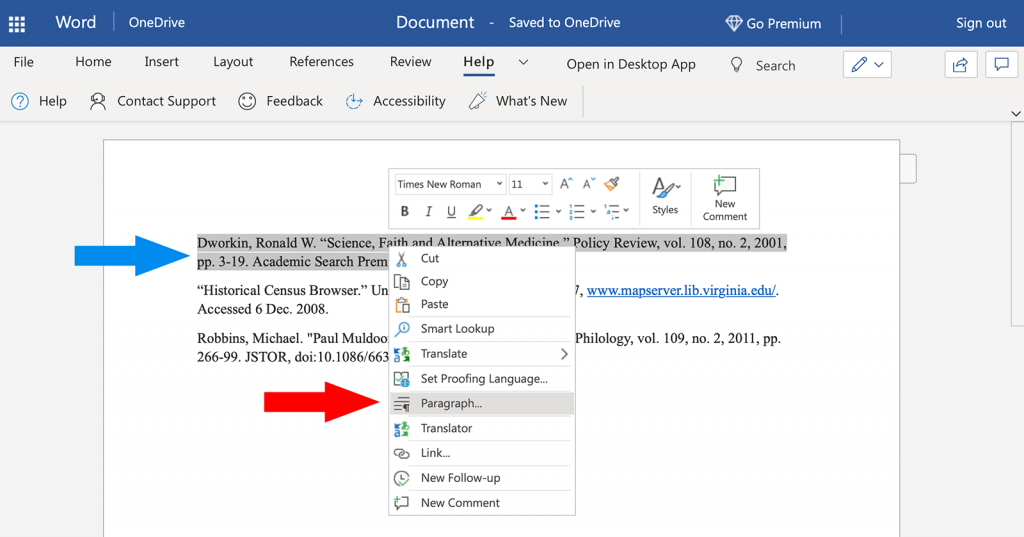
- See the “Indents and Spacing” tab.
- Select “Hanging” in the “Special” field under “Indentation.”
- Click, “OK.”
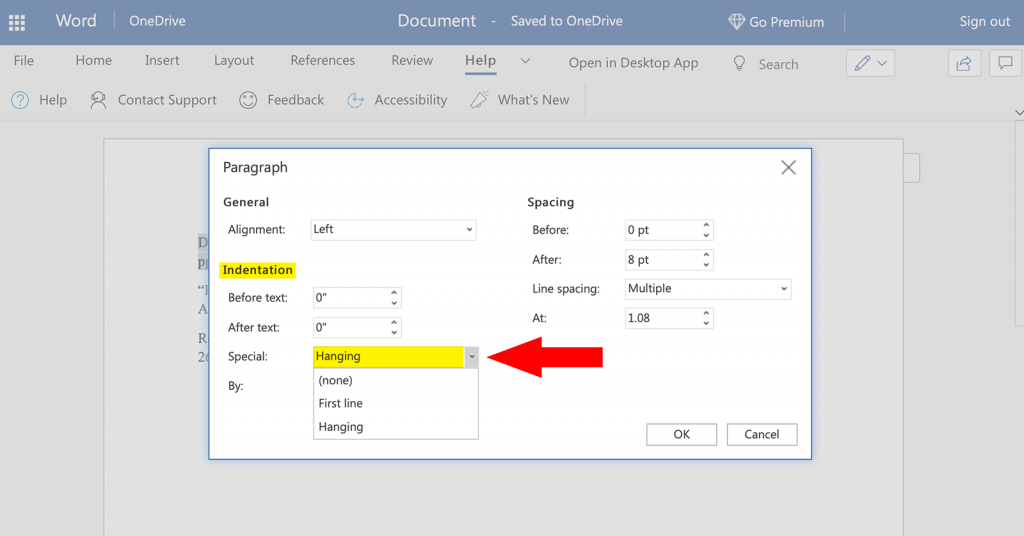
Indent a Citation Using the Drop-Down Menu in Word
In addition to right-clicking, you can also use the menu drop-down tab to create a second line indent for your works cited. For this method, follow these steps:
- Place your cursor at the beginning of your works cited entry.
- Click on the “Home” tab.
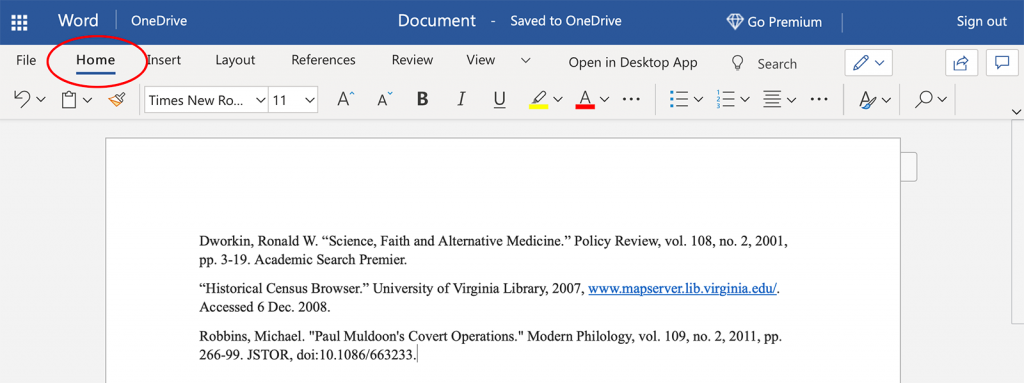
- Move to the “Paragraph” toolbar.
- Click on the small arrow located on the bottom right, next to the word “Paragraph.”
- View the “Indents and Spacing” tab.
- Pick “Hanging” in the “Special Indent” field.
- Click, “OK.”
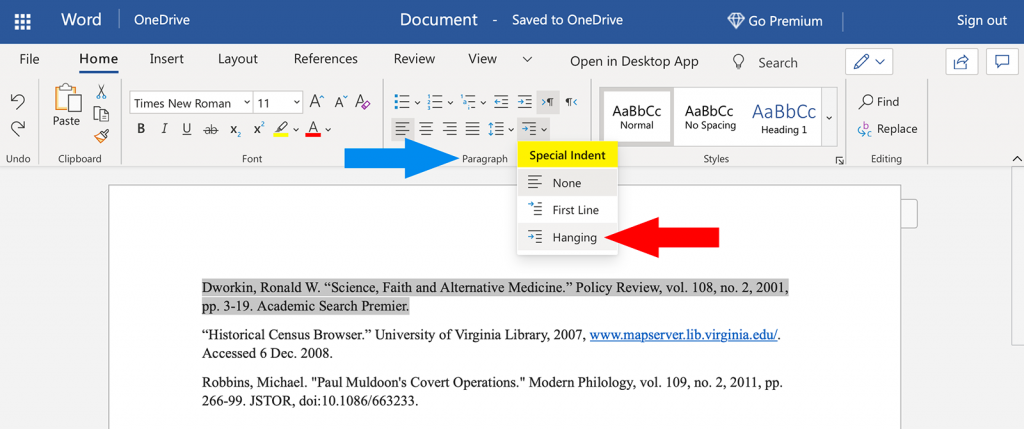
How to Make a Hanging Indent in Google Docs
For how to indent a citation and create a hanging indent in Google Docs, follow these steps:
- Place the cursor at the beginning of your text, highlighting the entry or entries.
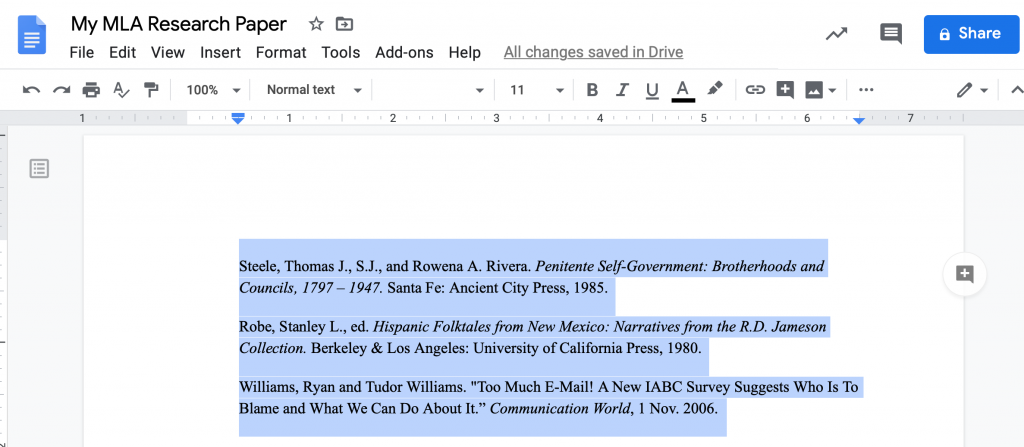
- Go to the “Format” drop-down menu.
- Select “Align & indent.”
- Select “Indentation options.”
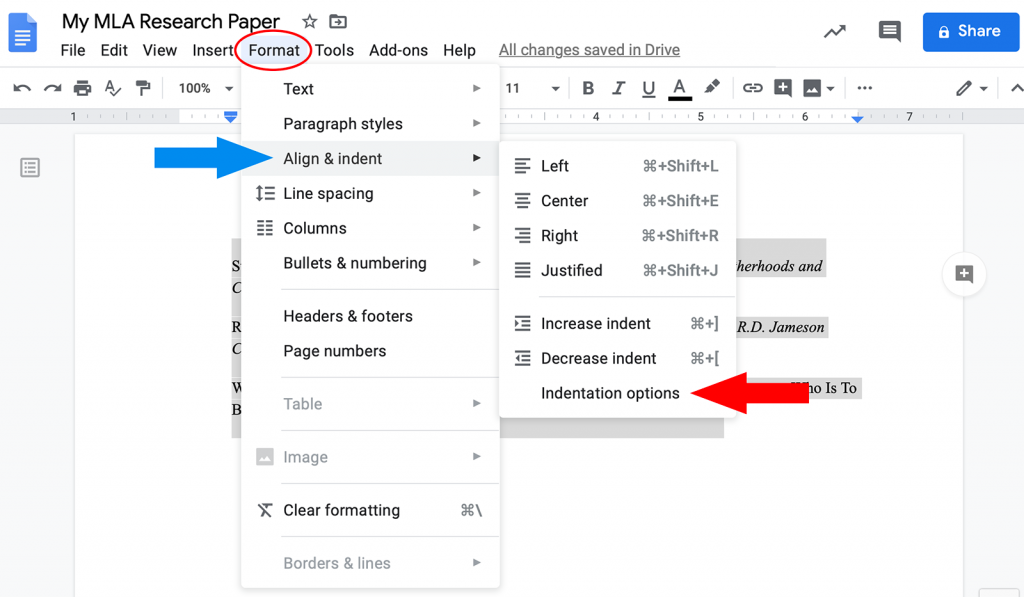
- In the “Special indent” field, select “Hanging.”
- The default indentation amount setting is 0.5 inches.
- Click “Apply.”
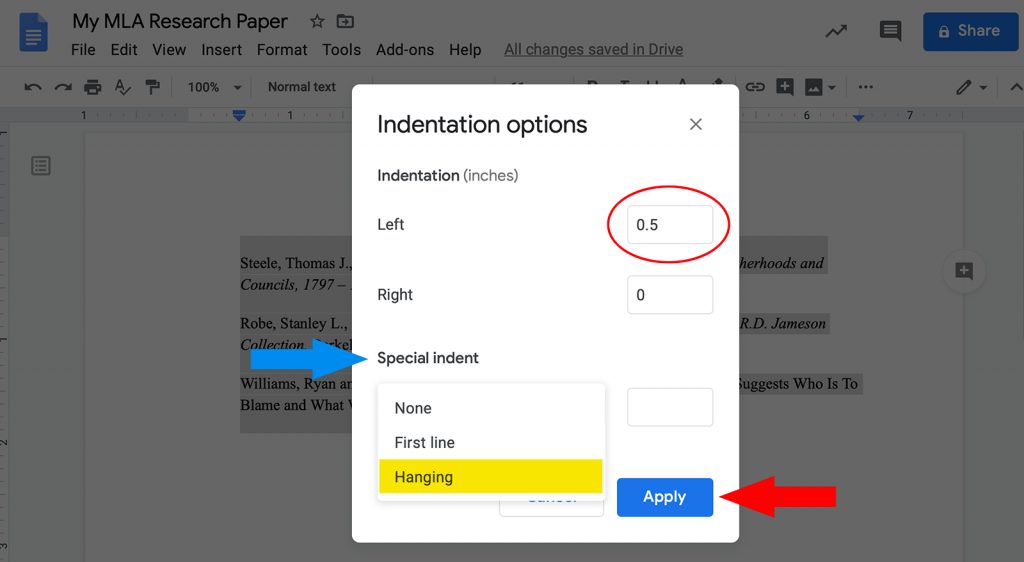 This is how the hanging indents in your MLA works cited list should look after applying these settings to your text.
This is how the hanging indents in your MLA works cited list should look after applying these settings to your text.

MLA Hanging Indent Examples – Works Cited
Once you know how to indent a citation, hanging indents for an MLA works cited are pretty easy to create. If your works cited entry is longer than two lines, keep using the hanging indent for additional lines. The hanging indent is used in formatting bibliographies, reference lists, and works cited pages to make each entry easier to read. Remember to double-space your citation sources as well.
MLA Works Cited Examples:
Steele, Thomas J., S.J., and Rowena A. Rivera. Penitente Self-Government: Brotherhoods and Councils, 1797 – 1947. Santa Fe: Ancient City Press, 1985.
Robe, Stanley L., ed. Hispanic Folktales from New Mexico: Narratives from the R.D. Jameson Collection. Berkeley & Los Angeles: University of California Press, 1980.
Williams, Ryan and Tudor Williams. “Too Much E-Mail! A New IABC Survey Suggests Who Is To Blame and What We Can Do About It.” Communication World, 1 Nov. 2006.
APA Hanging Indent Examples – Reference List
Now that you’ve looked at what the hanging indent looks like in MLA, it’s time to look at some examples of APA hanging indents. The APA inverse indent is created the same way.
Reference List Examples:
Train, T. J., and Rivera, R. A. (2010). Exploring the psyche. Yale University Press. https://doi.org/10.0598409539854039
Rainer, M. R. (Ed.). (1998). Psychology unplugged. University of California Press. https://doi.org/10.9438974923872908
Opening up the file drawer in cross-cultural psychology. (2020, October 14). Psychology Today. https://www.psychologytoday.com/us/blog/non-weird-science/202010/opening-the-file-drawer-in-cross-cultural-psychology
How to Format a Citation With Hanging Indents
Using hanging indents in MLA format is important when creating your bibliography, reference list, or works cited page. Remember to use Times New Roman 12 and to double-space your entries. Once you get the hang of it, creating hanging indents is easy to do.
FAQ Creating Hanging Indents for a MLA Works Cited
How do you create a hanging indent?
To create a hanging indent, you need to indent the second and subsequent lines of your citation 5 spaces or 1/2 inch. You can do this by hitting "Enter" at the end of a line and adding 5 spaces to your second line. Additionally, Microsoft Word and Google Docs have special commands to automatically format a hanging indent on your references page.
What's a hanging indent in works cited?
In a works cited, a hanging indent is when the second and subsequent lines of a citation are indented 1/2 inch. The use of the hanging indent on the second and subsequent lines of a citation helps to distinguish where one citation ends and another one begins.
How do you do a hanging indent for references?
You can create a hanging indent on a citation by pressing "Enter" at the end of the line and adding 5 spaces to the next line. However, Microsoft Word and Google Docs have specific tools for creating a hanging indent. In Microsoft Word, after highlighting the section, you select paragraph, indents and spacing, hanging, and indention. You then click “OK”. In Google Docs, highlight the section then hit format, align & indent, indention options, special indent, and hanging. You’ll then click “Apply”.
Why is my hanging indent not working?
In many cases, a hanging indent is not working because the correct commands in the word processing software were not given. Double-check the instructions to ensure you have given your word processing software the correct commands. An automatic hanging indent also might not work if you hit “Enter” to force your citation to the next line.
What is a hanging indent APA?
In APA style, a hanging indent is 1/2 inch added to the beginning of the second and subsequent lines of a citation on your references page. The indentation works to break up the different citations to help your readers see where one ends and another begins.

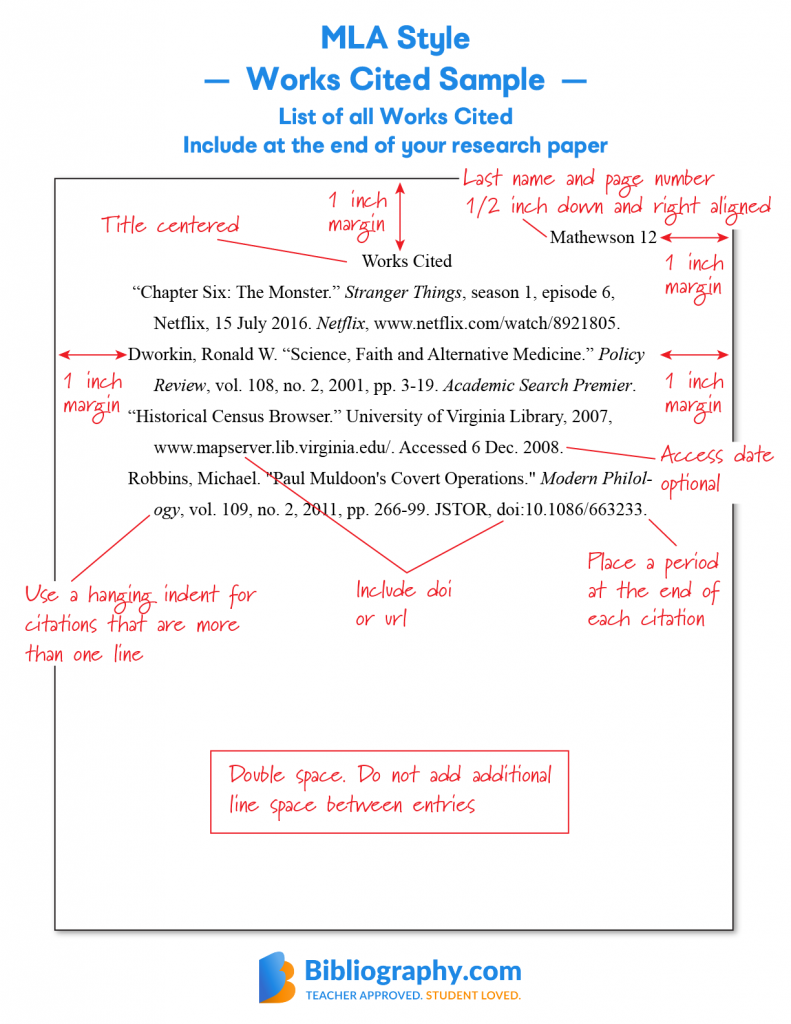
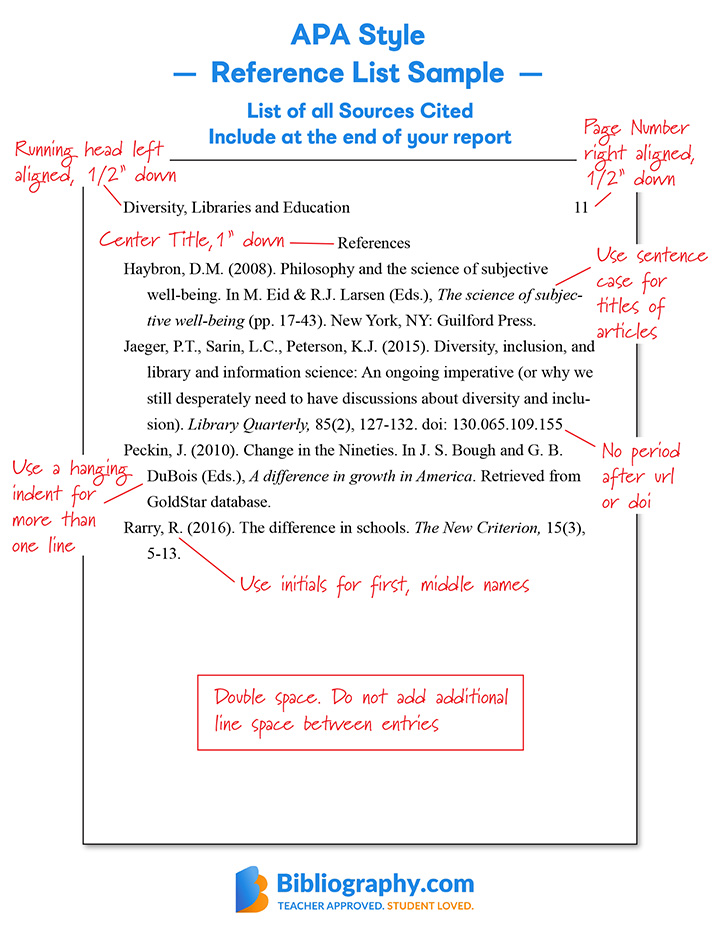
What is I go to the next line and it goes all the way back again. What if I accidentally mess up and have to delete so it moves back EVERYTHING?